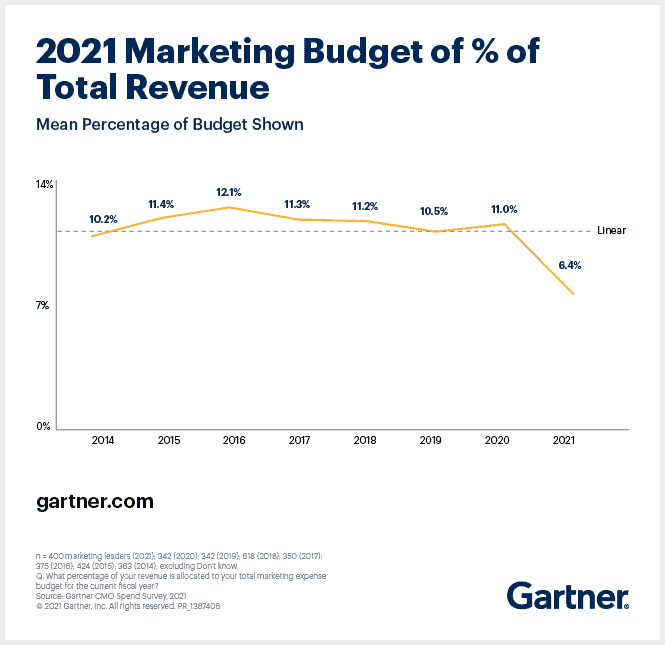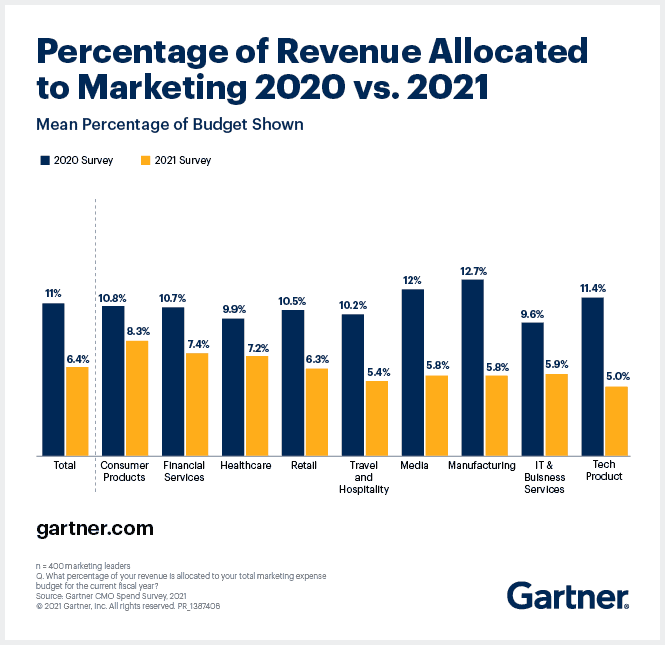Marketing budgets have fallen to their lowest recorded level, dropping to 6.4% of company revenue in 2021 from 11% in 2020.

Ewan McIntyre, co-chief of research and vice president analyst in the Gartner for Marketers practice said despite facing in-year budget cuts in 2020 due to the pandemic, most CMOs expected budgets to bounce back in 2021.
He warned this budgetary optimism was misplaced, as marketing budgets have fallen to their lowest level in the history of Gartner’s CMO Spend Survey (see Figure 1)
“However, these cuts have been a slow burn over the course of the last year, where many marketing budgets have not recovered what was originally lost,” he continued.
Figure 1.

The annual Gartner CMO Spend Survey, 2021 revealed that no one – regardless of company size or industry – has escaped swinging cuts in marketing budgets. In fact, no industry achieved a double-digit budget in 2021 (see Figure 2). Travel & hospitality, manufacturing and tech product companies have experienced the greatest cuts in 2021.
Meanwhile, consumer products and goods (CPG) companies reported the strongest 2021 marketing budgets at 8.3% of company revenue. Large enterprises got hit the hardest – companies with revenue of more than $2 billion reported the lowest average marketing budget of just 5.7%.
On the other hand, companies with revenue of under $500 million reported the highest allocation to marketing with an average budget of 8.6% of revenue.
Figure 2.

Reprioritize spend amid deep budget cuts
CMOs have shifted spending commitments across their channels and programs, with pure-play digital channels – owned, paid and earned – dominating those priorities and accounting for 72.2% of the total marketing budget.
When looking at the largest resource allocation – agencies, media, labour and paid media – agency spend continues to decline.
“Albeit a small dip from 23.7% in 2020 to 23% in 2021, this continual change indicates significant in-housing activity, as CMOs reimagine the capabilities that can be supported by their internal teams,” added McIntyre.
CMOs report that 29% of work previously carried out by agencies has moved in-house in just the last 12-months alone. The focus of in-housing is changing as well – with brand strategy, innovation and technology, and marketing strategy development making up the top three capabilities areas CMOs are moving to internal teams.
Marketing technology (martech) continues to dominate, taking up 26.6% of the total budget.
Digital commerce tops program spend
2020 and 2021 have seen drastic changes to customer buying journeys – both B2C and B2B alike, forcing even digital late-comers to accept the inevitable shift to online channels.
When looking at budget allocation by programs and operational areas, CMOs report digital commerce makes up 12.3% of the total budget.
Marketing operations and brand strategy make up 11.9% and 11.3% of the total budget.
However, while marketing analytics still commands 11% of the total budget, it has continuously dropped in prioritization – now in the fourth position in 2021.
McIntyre suggested that CMOs continue to invest in marketing data and analytics, however, for many, the results have failed to live up to expectations.
“Given recent and upcoming regulations, and changes in data collection, we expect this investment area to continue to be a strategically important capability, but also to continue to fluctuate until uncertainties subside,” he concluded.





